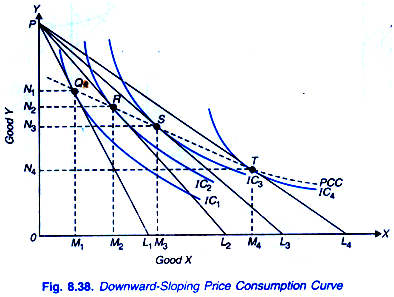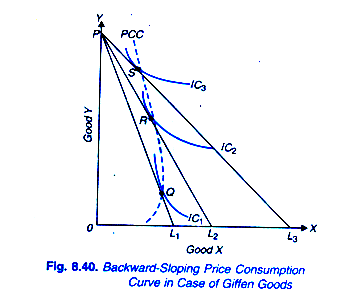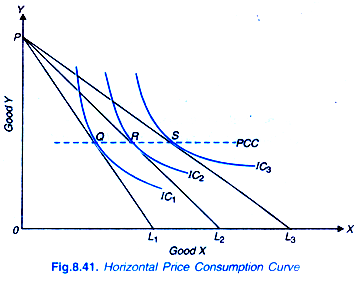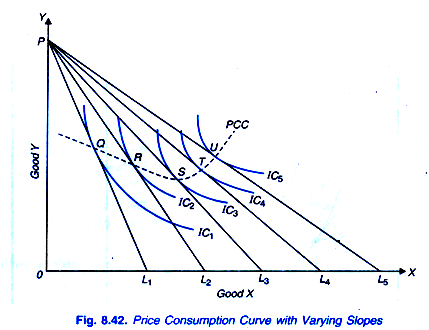We will explain how the consumer reacts to charges in the price of a good, his money income, tastes and prices of other goods remaining the same.
Price effect shows this reaction of the consumer and measures the full effect of the change in the price of a good on the quantity purchased since no compensating variation in income is made in this case.
When the price of a good charges, the consumer would be either better off or worse off than before, depending upon whether the price falls or rises.
In other words, as a result of change in price of a good, his equilibrium position would lie at a higher indifference curve in case of the fall in price and at a lower indifference curve in case of the rise in price.
ADVERTISEMENTS:
Price effect is shown in Fig. 8.38. With given prices of goods X and Y, and a given money income as represented by the budget line PL1, the consumer is in equilibrium at Q on indifference curve IC1. In this equilibrium position at Q, he is buying OM1 of X and ON1 of Y. Let price of good X fall, price of Y and his money income remaining unchanged. As a result of this price change, budget line shifts to the position PL2.
The consumer is now in equilibrium at R on a higher indifference curve IC2 and is buying OM2 of X and ON2 of Y. He has thus become better off, that is, his level of satisfaction has increased as a consequence of the fall in the price of good X. Suppose that price of X further falls so that PL3 is now the relevant budget line. With budget line PL3 the consumer is in equilibrium at S on indifference curve IC3 where he has OM3 of X and ON3 of Y.
If price of good X falls still further so that budget line now takes the position of PL4, the consumer now attains equilibrium at T on indifference curve IC4 and has OM4 of X and ON4 of Y. When all the equilibrium points such as Q, R, S, and T are joined together, we get what is called Price Consumption Curve (PCC). Price consumption curve traces out the price effect. It shows how the changes in price of good X will affect the consumer’s purchases of X, price of Y, his tastes and money income remaining unaltered.
In Fig.8.38 price consumption curve (PCC) is sloping downward. Downward-sloping price consumption curve for good X means that as price of good X falls, the consumer purchases a larger quantity of good X and a smaller quantity of good Y. This is quite evident from Fig. 8.38. We obtain downward-sloping price consumption curve for good X when demand for it is elastic (i.e., price elasticity is greater than one). But downward sloping is one possible shape of price consumption curve. Price consumption curve can have other shapes also.
ADVERTISEMENTS:
In Fig. 8.39 upward- sloping price consumption curve is shown. Upward-sloping price consumption curve for X means that when the price of good X falls, the quantity demanded of both goods X and Y rises. We obtain the upward-sloping price consumption curve for good X when the demand for good is inelastic, (i.e., price elasticity is less than one).
Price consumption curve can also have a backward-sloping shape, which is depicted in Fig. 8.40. Backward-sloping price consumption curve for good X indicates that when price of X falls, after a point smaller quantity of it is demanded or purchased.
Price consumption curve for a good can take horizontal shape too. It means that when the price of the good X declines, its quantity purchased increases proportionately but quantity purchased of good Y remains the same. Horizontal price consumption curve is shown in Fig. 8.41. We obtain horizontal price consumption curve of good X when the price elasticity of demand for good X is equal to unity.
But it is rarely found that price consumption curve slopes downward throughout or slopes upward throughout or slopes backward throughout. More generally, price consumption curve has different slopes at different price ranges. At higher price levels it generally slopes downward, and it may then have a horizontal shape for some price ranges but ultimately it will be sloping upward.
For some price ranges it can be backward sloping as in case of Giffen goods. A price consumption curve which has different shapes or slopes at different price ranges is drawn in Fig. 8.42. Such a type of price consumption curve means that price elasticity of demand varies at different price ranges.




